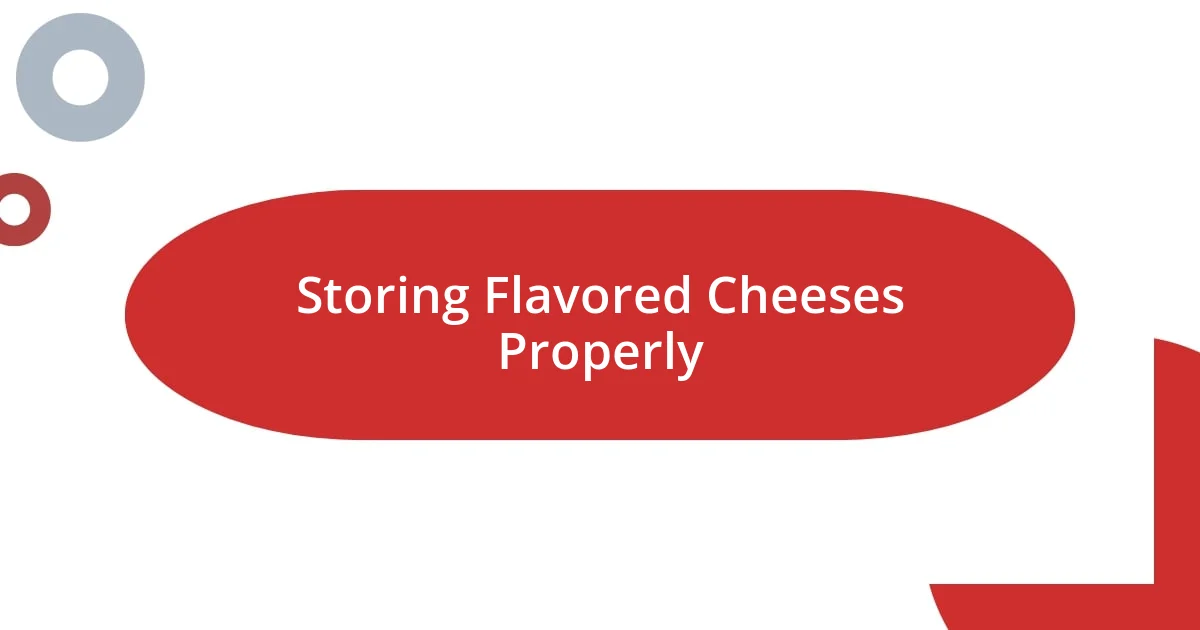Key takeaways:
- Flavored cheeses combine traditional cheese-making with innovative flavors, creating unique culinary experiences that evoke memories and emotions.
- Choosing quality cheeses involves considering freshness, milk source, and aging processes, which all significantly impact flavor and texture.
- Experimenting with flavor pairing and infusion techniques can enhance tasting experiences, and sharing feedback on these flavors fosters appreciation and creativity in cheese exploration.

Understanding Flavored Cheeses
Flavored cheeses are a delightful fusion of traditional cheese-making and innovative culinary experimentation. I remember the first time I tried a garlic and herb goat cheese; the explosion of flavor made me rethink what cheese could really be. It made me wonder—why stick to the classics when there’s a whole world of tastes waiting to be explored?
When we talk about flavored cheeses, we’re not just discussing ingredients. Each cheese carries a story, a reflection of its origin and the creativity of its maker. For instance, I once attended a cheese festival where I sampled a smoky cheddar that immediately transported me to a cozy cabin in the woods. Isn’t it fascinating how a single bite can evoke such vivid memories and emotions?
Understanding flavored cheeses also means appreciating the balance that goes into creating them. I often find myself questioning whether the flavorings enhance or overshadow the cheese’s natural qualities. The best flavored cheeses, in my experience, strike a perfect equilibrium, allowing the base cheese to shine while introducing intriguing nuances. How do you feel about that balance?

Choosing Quality Cheese Types
When choosing quality cheese types, I find it essential to consider the freshness of the product. I recall visiting a local cheese shop where I was fortunate enough to sample a wheel of brie that had just been made. The creaminess and depth of flavor were unlike anything I’d had before. Freshness truly does play a significant role in the overall taste experience.
Another aspect I always evaluate is the cheese’s milk source—cow, goat, or sheep. Each type brings its unique characteristics and flavor profile. For example, I structured a tasting where I paired a sharp goat cheese with honey. The tanginess of the cheese perfectly complemented the sweetness, creating a wonderful harmony. Have you ever experimented with different milk types? The possibilities are endless and can greatly affect the final taste.
Lastly, the aging process of a cheese can dramatically impact its flavor and texture. I once tried a lesson in cheese-making that involved an aged gouda, and the complexity of flavors, from nutty to caramel-like, was remarkable. Aged cheeses often develop intense flavors, so I suggest looking for artisanal varieties, as they usually showcase exceptional craftsmanship. Good cheese deserves quality attention—don’t you think?
| Cheese Type | Milk Source |
|---|---|
| Brie | Cow |
| Chèvre (Goat Cheese) | Goat |
| Manchego | Sheep |

Basics of Flavor Pairing
When it comes to flavor pairing, understanding the basic profiles can be a game changer in your cheese experiments. I’ve often found that sweet, salty, and umami flavors can play beautifully together. For instance, I once created a charcuterie board featuring a creamy blue cheese dressed with a drizzle of honey and sprinkled with crushed walnuts. The blend of flavors not only heightened each ingredient but also transformed an ordinary cheese platter into an extraordinary experience.
Here are a few fundamental principles to consider when pairing flavors with cheese:
- Sweetness: Honey, figs, and dried fruits can bring out the creaminess in cheeses like brie and goat cheese.
- Salty: Olives or cured meats enhance sharp cheeses, like aged cheddar or Parmigiano-Reggiano, creating a savory balance.
- Acidity: Pairing cheeses with pickles or citrus can cut through the richness, as I’ve enjoyed with tangy goat cheese and lemon zest.
- Herbs and Spices: Fresh herbs or a sprinkle of cayenne can add refreshing and spicy notes that elevate the experience.
- Fat: Creamy cheeses work wonders with rich toppings; I once enjoyed a luscious mascarpone paired with dark chocolate, and it was an indulgent treat.
Breaking down flavor pairings has truly enriched my culinary journey, as I continually discover what combinations ignite my senses and create lasting memories.

Techniques for Flavor Infusion
To infuse flavors into cheese, one of my favorite techniques is marinating. I remember a summer evening when I decided to soak fresh mozzarella in olive oil, garlic, and herbs. The result was a flavor explosion that elevated every dish I paired it with – from salads to bruschetta. It got me thinking: how much more exciting can cheese get with a simple infusion like this?
Another approach I’ve found incredibly rewarding is using spices and rubs. A few months ago, I experimented with a handful of smoked paprika on a block of cheddar. After letting it sit for a few hours, the cheese took on a delightful warmth and depth that transformed my grilled cheese sandwich into something truly gourmet. Have you ever tried such a straightforward technique? It’s amazing how a dash of seasoning can completely alter the taste.
Finally, consider the art of aging or cold smoking your cheese. I once attended a workshop where we cold-smoked gouda over applewood chips, and I was captivated by the complexity introduced by just a couple of hours in the smoker. The nuttiness combined with a whisper of smoke was enchanting! It led me to wonder if I could replicate that process at home. What flavors would you want to try infusing into your cheeses? The possibilities feel limitless!

Testing Flavor Combinations
When I dive into testing flavor combinations, I always start with a concept I’ve dubbed “flavor harmony.” Recently, I paired a smoky gouda with a sweet Fig Jam. The contrast between the rich, savory notes and the sweetness created a delightful balance that had my taste buds dancing. Have you ever experienced such a surprising revelation in pairing? It genuinely opened my eyes to the layers hidden within seemingly contrasting flavors.
Another memorable experiment involved combining feta cheese with watermelon and mint. The refreshing crunch of the watermelon against the creamy feta was a summer delight. I vividly recall sharing this with friends during a warm evening, and their reactions were priceless! It’s those moments of joy that make experimenting worthwhile. The interplay of the salty and sweet is one I recommend trying if you haven’t already – it could become your new favorite.
Lastly, I have found that keeping an open mindset while testing combinations is essential. I recall the time I threw together goat cheese, blueberries, and a touch of black pepper for a spontaneous snack. The tartness of the blueberries complemented the creaminess of the cheese perfectly, while the pepper added an unexpected kick. It made me wonder about the hidden potential in ingredients that sit forgotten in the fridge. What hidden gems might you discover in your own kitchen? Understanding that every flavor can reveal unexpected friendships truly enhances the excitement of exploration.

Storing Flavored Cheeses Properly
When it comes to storing flavored cheeses, I’ve learned that preserving their unique tastes is essential. I once had a delightful batch of herbed chèvre that started losing its vibrancy simply because I didn’t wrap it properly. After that lesson, I always opt for wax paper and keep the cheese in an airtight container to maintain its delightful flavors. Have you ever noticed how a little care can go a long way in extending the life of your cheese?
Temperature also plays a crucial role in storage. I remember a particularly hot summer when some delicious garlic-infused cream cheese began to spoil faster than I anticipated. Now, I aim to keep my flavored cheeses in the cooler part of the fridge, usually towards the back. This way, they stay fresh longer. Have you ever considered how much a few degrees can change the game when it comes to flavor retention?
Another tip that has served me well is labeling. I once made several infused cheeses—think chili and lime brie—and ended up confused about which was which. Now, I date my cheeses and note their flavors right on the container. It saves me from any mix-ups and helps me enjoy each unique experience fully. Are there any methods you use to keep your cheese collection organized? It truly makes a difference in my flavored cheese adventures.

Sharing Experience and Feedback
Sharing my experiences about flavored cheeses not only enriches my tastings but also opens avenues for feedback. I remember once hosting a little cheese-tasting soirée, encouraging friends to share their thoughts on a honey-infused brie. Their laughter and candid reactions brought such warmth to the evening, and I was surprised by how their insights turned what I thought was a straightforward pairing into a lively debate over flavors. Have you ever stumbled upon a flavor that sparked an unexpected conversation?
Another time, while sampling a blue cheese with a spice blend, I noticed that reactions varied widely; some were enamored by the boldness, while others found it overwhelming. This prompted me to create a little feedback card for my guests, inviting them to jot down their impressions. The different perspectives not only provided me with a clearer understanding of preferences but also deepened my appreciation for the diverse ways we interpret flavors. Wouldn’t it be fascinating to see how others experience what you love?
In my testing, I often ask friends to provide their input on pairing suggestions too. Recently, I ventured into blending a truffle-infused cheese with a sweet apple chutney, and the collective “oohs” and “ahs” ignited my passion even further. Capturing these thoughts and responses transforms my experiments into collaborative adventures. Have you taken the time to gather feedback about your cheese explorations? It truly can enhance the way you appreciate your culinary creations.















